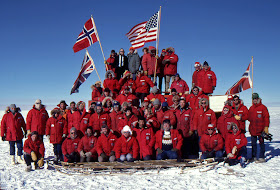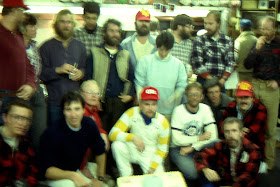Roald Amundsen and four others from Norway had been trekking across the Antarctic continent by sled and dog team for 54 days when they finally arrived at 90° south on December 14, 1911. Amundsen and his team were thus the first people to ever stand at the very bottom of the Earth! Wednesday marks the 100th anniversary of this exploration milestone and in honor of it, I am sharing some of my photographs from my stint at the South Pole Station in December/January, 1986, when the 75th Anniversary of Amundsen's feat was commemorated. In this portfolio you will also see images of McMurdo Station from the winter of 1986-87. At the South Pole Station on December 14, 1986 about 46 of the 64 persons stationed at the Pole that day went outside on a bright and sunny day and remembered Roald Amundsen, Robert Scott, and their men.
This is (or was?) the National Science Foundation headquarters at McMurdo Station in 1986. The flags of the original 13 Antarctic Treaty signees fly in front of the building. Antarctica is the only continent dedicated to science and peace.
A view of a "street" in old McMurdo Station. I am sure that the buildings here have now been replaced.
Playing hacky-sack in front of the church in McMurdo, January, 1987. A bit of Observatory Hill is visible in the right background.
Here is the entire McMurdo Station as viewed from the top of Observatory Hill in November, 1986. Note the frozen Ross Sea in the upper left. Scott's Discovery Hut (1902) is located on the small peninsula jutting out into the sea.
I volunteered to help various geologists conduct their research. Here I am (on the left) working a tool that drills through the sea ice. Yes, we are out to sea in this photograph and standing on frozen ocean, where the sea ice is about 10 feet thick. Once we drilled a hole in the ice, we dropped a coring device that hit the ocean bottom about 1,600 feet down and brought up whatever sediment had accumulated there over many thousands of years. This was research being conducted by Dr. Rob Dunbar, then of Rice University but now at Stanford.
An outdoor picnic at McMurdo Station, November, 1986.
On December 13, I received orders to report to the South Pole Station at 90° south. Here we are flying over the Shackleton Glacier (or was it the Beardmore?) with the Trans-Antarctic Mountains in the distance. These mountains are about 5,000 miles long and are a fantastic trove of earth history
Of course, the bottom of the world is upside down and when I walked off the C-130 airplane, this is what I saw. I'll turn the rest of the photographs "up-side down" so that you can see them better.
The old sign in front of the South Pole Station. Back in these days it was called USARP - the United States Antarctic Research Program. Now I believe it is called simply USAP - the United States Antarctic Program.
This is the main entrance to the old dome as it looked in December, 1986.
Here is the official 75th Anniversary photograph on December 14, 1986. We were commemorating the first arrival of Amundsen and his men at the South Pole on December 14, 1911. I am in the front row, third person on the right (light colored shirt beneath the jacket). We decided to hoist the Norwegian, British and American flags for the commemoration. Why not - Scott arrived only five weeks later and after 100 years, that is essentially the same time. I think Amundsen would agree that it's close enough.
I stepped out from the group photo to take one of my own in color
The galley crew made a cake for the occasion that shows the old South Pole Station on top of it. Nice!
This is a blurry photo taken of the group after we returned to inside the dome, with the baker kneeling in front of the cake below. It was dark in there and this was film photography, so that is why the photo is blurred.
A rousing celebration at the South Pole on Christmas Day, December 25, 1986. Even though a lot of work is performed at these stations, every day is a holiday at the South Pole. Temperature here a brisk -30° F.
The reason for my stint at the South Pole Station is that the Clean Air Facility (about 10 years old) was becoming buried in snow drifts and we were sent to hoist it up using pneumatic technology. Previous attempts in other southern summers had failed. The conditions were cold and windy. I saw a wind chill of -60° F, and the warmest it ever got was -6° F. Not cold you say, but this was summer time!
After three weeks, we had the building up on steel girders and were ready to lock it in place. The snow accumulated here at about one foot per year, so all buildings are subject to being buried.
After only 20 minutes in the cold, one's beard begins to get heavy
There was a "warm-up" hut located nearby with hot coffee and soup and most of us needed to go inside at least every 30 minutes - even with our Antarctic clothing
The glacial ice "drifts" over the pole of the earth at about 10 meters per year. This means that the official marker must be moved each year. You might see a small marker located between the two poles on the sign - this was the exact pole position on January 1, 1987. My feet frame the view (below).
The sign shows that the land at the South Pole is very close to sea level but that the ice thickness is about 9,000 feet. Not only is it cold here but there is not much oxygen!
In December of 2002, I returned to the South Pole with a group of visitors. We took an eight hour flight (with a refueling stop on the ice along the way) to the Pole from a camp we were staying at.
This is the view about half way to the pole. 90% of the planets fresh water is tied up in Antarctic ice!
At this time, a new South Pole station was being built near the old dome.
The material for this station was brought in overland from McMurdo Station on an Ice Highway. Read about it here. This station is designed so that it can be uplifted as the snow begins to pile up around its base.
Research in Antarctica continues today and to read a recent article about a sub-glacial mountain range on the White Continent, click here. And to read the blog of Dr. Ed Stump who has conducted 40 years of research in the Trans-Antarctic Mountains, click here.

























Wow, what an awesome adventure. And then to return and see the changes. I'll just enjoy it from here as I don't tolerate cold well.
ReplyDelete